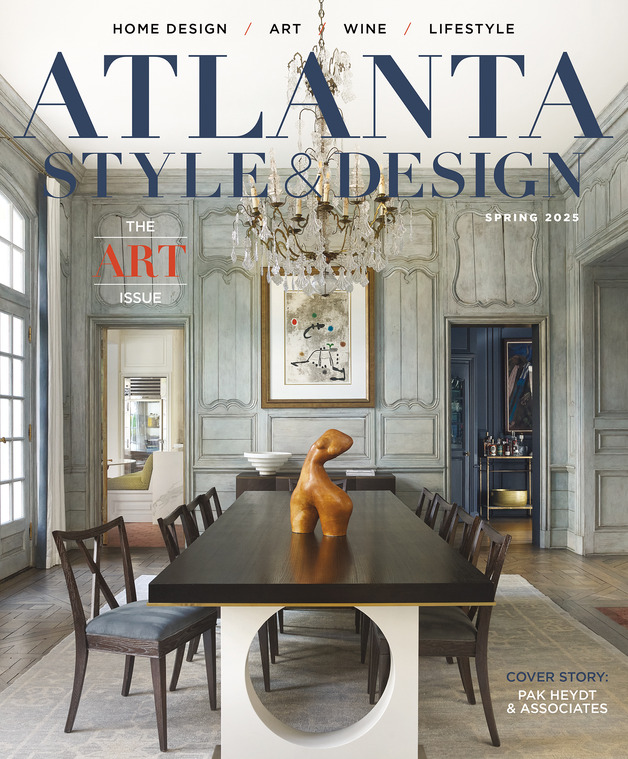
With a Persian pedigree such as the Kashanis’, it seems only natural that the family would emerge as an authority on finely crafted antique Persian and Oriental rugs in the Atlanta area and around the country. Hailing from Isfahan, Iran’s center of art, the Kashani brothers grew up immersed in the sophisticated culture and ornate architecture for which the ancient Persian city—once its capital—is famous. Their enterprise, Persian Galleries, brings to market a cultural heritage that’s displayed and appreciated in private homes and public museums across the United States.
“Through the years we have established ourselves as a primary source for both antique and contemporary rugs from around the world,” says Mike Kashani, founder of Persian Galleries. “We work with local designers and understand what the market demands, and we are very experienced in recommending appropriate patterns and color combinations.”

Kashani came to the United States in 1978 to further his education in the architectural field at Southern Polytechnic State University. Shortly after graduation, he sensed a shift in home décor trends toward hardwood flooring and, seeing a niche for area rugs in the Atlanta market, opened a small, 1,000-square-foot showroom in 1984 in prestigious Buckhead, filling it with rugs sent from Iran by brothers Mohammed, Max and Ken Kashani.
“Before I knew it, I had the need to expand,” Kashani notes. “It was just the right time—it was a case of me needing the business and the business needing me. It took off. I acquired a second property, and Max and Ken decided to join me as partners in the business.” Mohammed Kashani would later open a similar showroom, Atlanta Fine Rugs & Antiques, adding home décor to his offerings.
The family business continued to expand, with the brothers adding to their portfolio additional showrooms in Knoxville and Nashville, Tennessee, and Naples, Florida. Persian Galleries widened its offerings to include the art of the Dutch masters.


“It was a fantastic opportunity for our family,” Kashani says. “We were catering to a very high-end clientele. We sold to many celebrities and national museums; I was also a consultant for the High Museum of Art regarding restorations and repairs of exhibits and rugs the museum had purchased. I have also hosted many lectures on the collectability, origins, motifs and heritage of classical and tribal carpets.”
By 1989, Persian Galleries was doing business with such high-profile clients as Georgia governor Joe Frank Harris, who acquired a number of rugs and tapestries for the Governor’s Mansion.
“The Harrises also had carpets in need of top-quality restorative work,” Kashani says. “That’s our expertise—we love to preserve the beauty of these rugs because they are made by hand, and a skilled technician can revive them and bring them back to life.”
Kashani adds that his staff is very service-oriented. “We are passionate about every facet of the business—all of it,” he says.
Producing exhibitions that highlight its inventory of particularly significant rugs is also part of Persian Galleries’ services. Kashani says he has staged several at Lowndes Grove in historic Charleston. The thoughtfully preserved 18th-century property is listed on the National Register of Historic Places and is a sought-after wedding venue. “We’ve worked with a number of designers in that beautiful city,” Kashani says.

A connoisseur of historic architecture and old masters paintings, as well as distinguished rugs, his love of all things fine led him to author a book titled The Painted Prophecies of Cornelis van Haarlem, da Vinci of the Dutch. “It explores the artwork of Cornelis Cornelisz van Haarlem,” Kashani says. “Art historians called him the ‘Michelangelo of the North’ and the ‘da Vinci of the Dutch.’ I acquired his 1594 battle scene, Single Combat, and have been on a mission to authenticate the painting and decode it.” Painted Prophecies chronicles Kashani’s 20-year journey researching the artistic, religious and political landscape of the late Renaissance that positioned Cornelis Cornelisz van Haarlem at the sunset of Mannerism and the dawn of baroque art.
Persian Galleries’ collection of rugs reflects a wealth of connections the family enjoys and the “finds” that result from travels abroad. “Our rugs come from all over—Oushak, Serapi, Heriz, Sarouk Farahan, Tabriz—we carry a wide variety of rugs, and we have some say in the production of the new rugs,” Kashani shares. “We work with very small villages in Iran and Turkey. We source one-of-a-kind nomadic rugs from northwest Persia and parts of Russia, like the Caucasus, Kazak, Shirvan. They are handmade, with unique designs that are produced in a primitive manner with materials provided by nature, and they don’t have the high density of knotting you see in rugs made in bigger cities on bigger looms.” Kashani says most of the fine silk rugs Persian Galleries offers are produced in the ancient cities of Isfahan, Qom and Tabriz, and there are no machines involved in the production of any of them.

What also sets the company apart is that it leads the market in producing antique-style rugs with all-natural dyes and the finest spun wool. “We identify old designs that are really very beautiful and use the exact same technique to recreate the antique look in a rug that is brand-new,” Kashani explains. “The best part about it is, you don’t have to worry about usage; the more you use it, the better it becomes. Just like good wine and pearls—with age, they get better. With every step, you increase the value of the rug. The true beauty of the rug comes alive.”
Through the Kashani family’s deep heritage and love of the arts, Persian Galleries brings to life the story of ancient Asian cultures in every rug—old and new. *
Wendy Swat Snyder is a Charleston-based freelance writer (sweetgrassandgrits.com).

